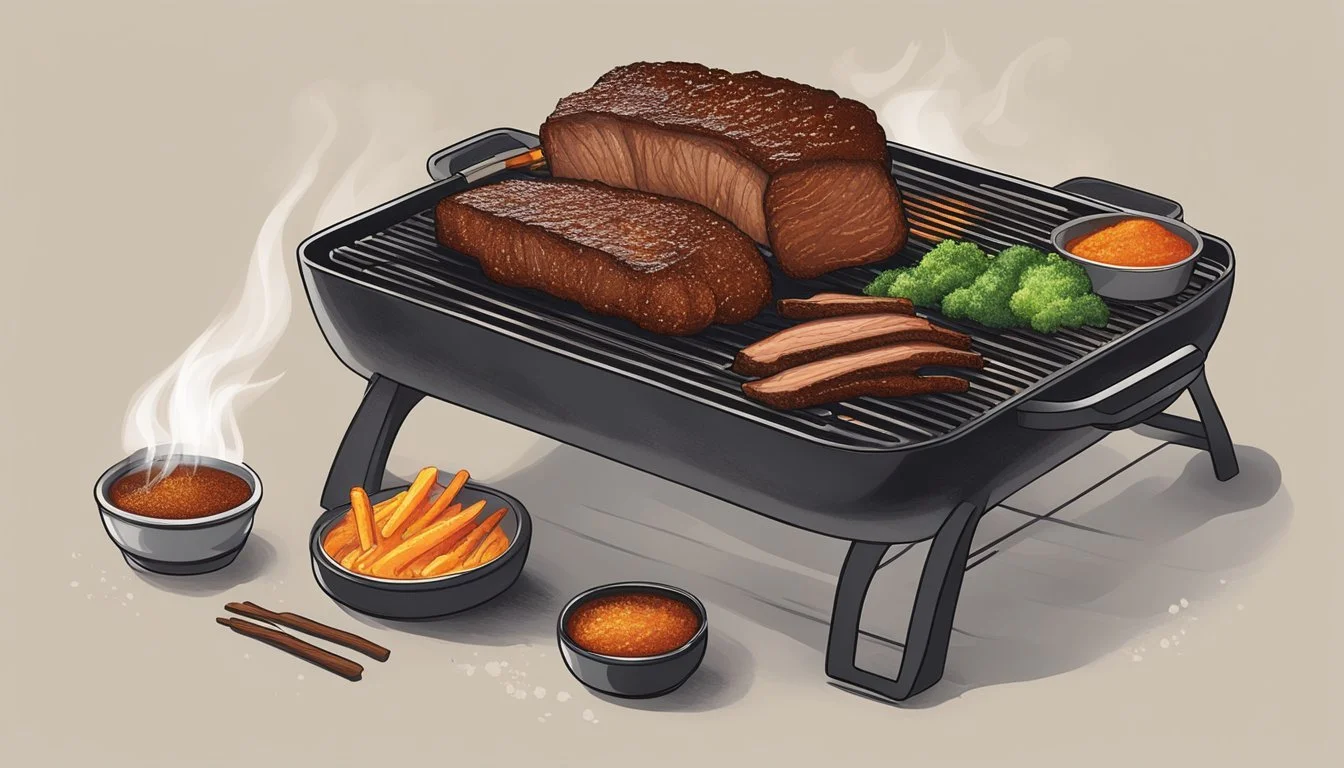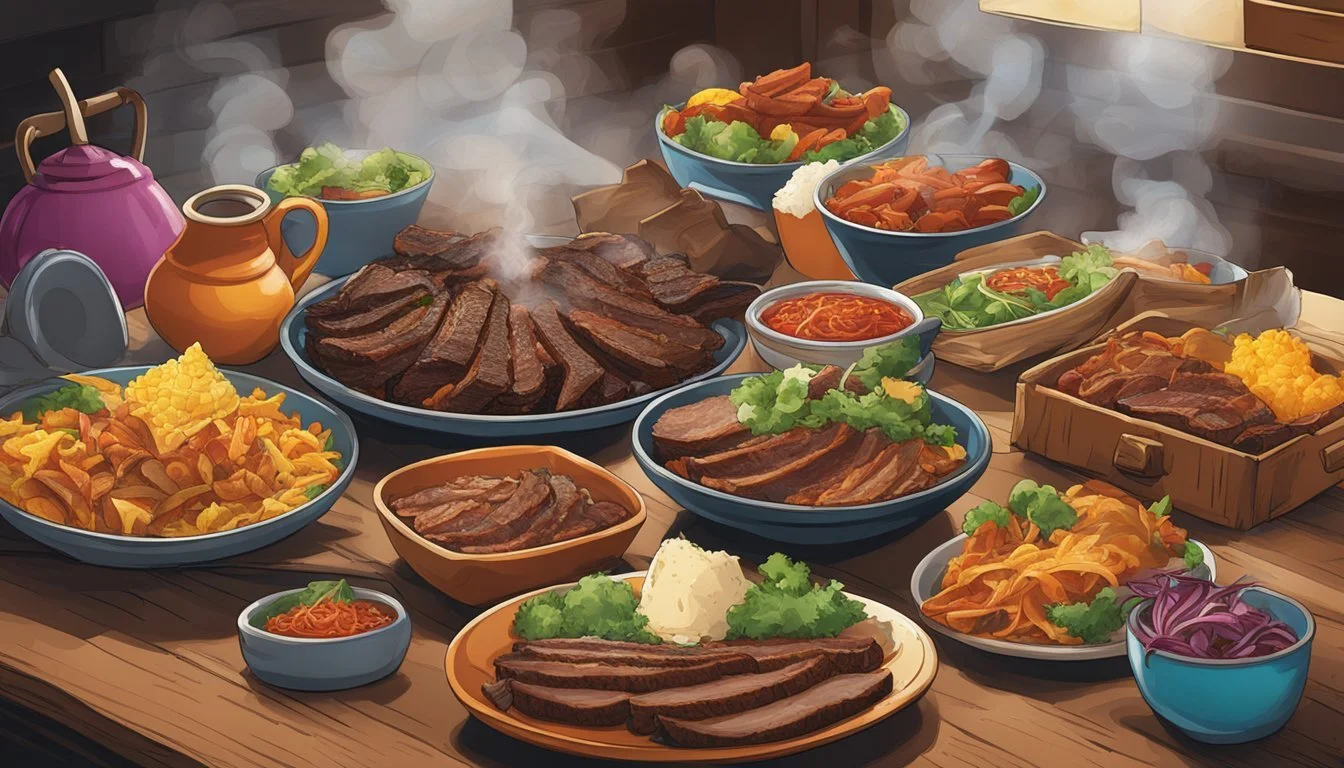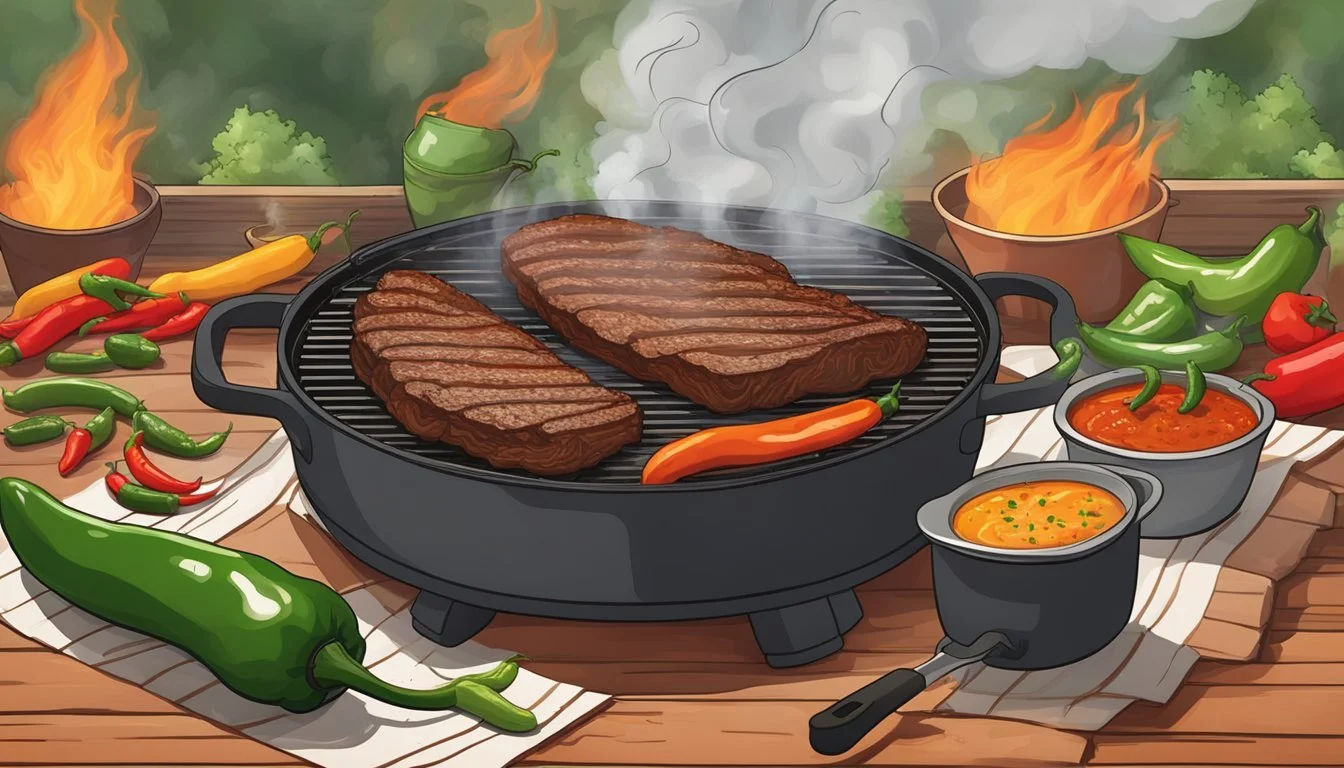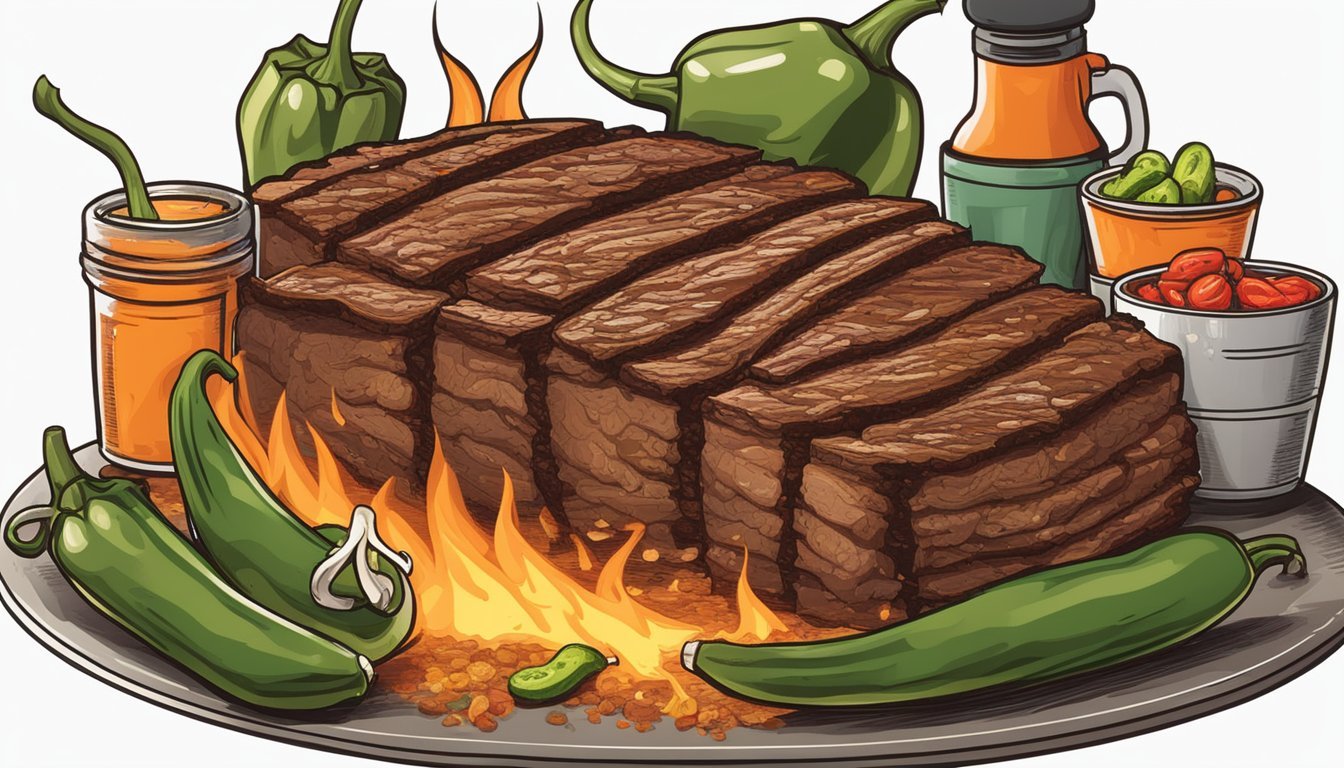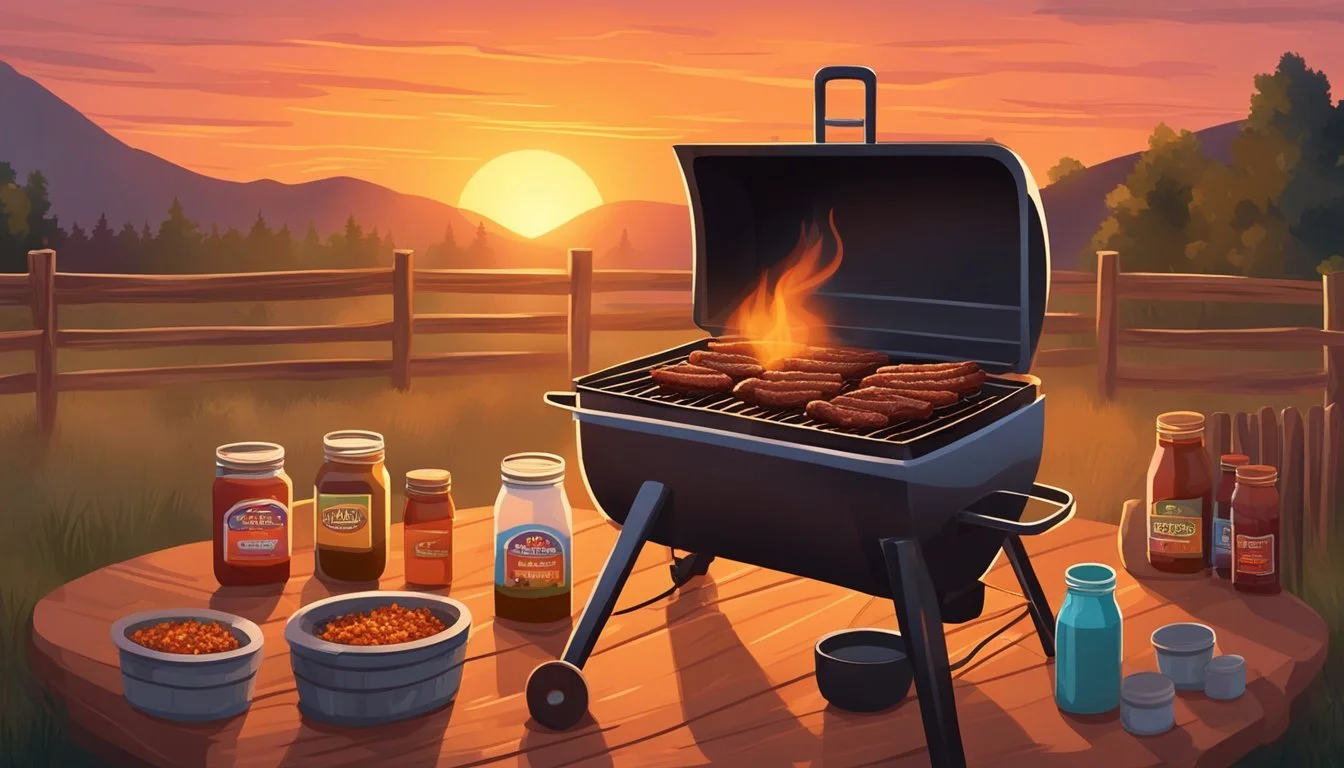The Spiciest Texas Brisket Recipes
Igniting BBQ Traditions with Heat
Texas brisket is a revered classic in barbecue culture, renowned for its smoky depth and tender succulence. Traditionally, this delicacy is a meticulous blend of simple seasonings and slow, patient cooking, coaxing out the meat's robust flavors over a wood-fired smoker. The essence of a good Texas smoked brisket recipe lies in the preparation of the meat, often with a brisk seasoning of salt and pepper, and in managing the smoker to maintain the perfect temperature, ensuring the brisket emerges with a desirable bark and juicy interior.
To introduce a fiery twist to this time-honored dish, some enthusiasts infuse the recipe with bold spices, elevating the heat to create a spicier version of the Texas-style smoked beef brisket. (What wine goes well with beef brisket?) This spicy take on the original does more than just tingle the palate; it integrates the heat with the natural flavors of the brisket, creating a harmonious balance that showcases the versatility of this Southern favorite. Whether it involves mixing in cayenne pepper with the traditional salt and pepper rub, or serving the brisket with a spicy sauce comprised of chili peppers and other piquant ingredients, these recipes are about finding the right level of spice to complement rather than overwhelm the meat's intrinsic flavors.
The Essentials of Texas Brisket
Texas brisket commands a mastery of meat selection, wood choice, and smoking technique. The journey to creating a mouthwatering brisket begins long before the meat hits the grill.
Understanding Brisket: From Choice to Prime
Brisket is a cut of beef from the breast section of the cow, known for its rich flavor and tender qualities when cooked properly. There are various grades to consider:
Select: Leaner with less marbling; can be tougher if not cooked correctly.
Choice: More marbling than select, offering a balance of tenderness and flavor.
Prime: Highest quality with abundant marbling, resulting in exceptional tenderness and taste.
Selecting the right grade is crucial, as the marbling will impact the brisket's moisture and flavor after long hours in the smoker.
Choosing Your Wood: Oak, Hickory, or Mesquite
Wood is the essence of Texas barbecue, imparting distinct flavors:
Oak: A traditional choice that burns slowly and evenly, offering a medium smoky flavor.
Hickory: Provides a stronger, sweet to savory smoke taste, complementing the beef.
Mesquite: Imparts an intense and earthy flavor, best used sparingly due to its boldness.
Each type of hardwood contributes uniquely to the brisket's final taste, and many pitmasters blend woods to create a signature smoke profile.
Preparing Your Smoker and Equipment
Proper preparation of the smoker ensures even cooking and efficient smoke flow. Here's what's necessary:
Smoker: Offset, pellet smoker, or any reliable smoker that maintains consistent temperatures.
Temperature: Aim for a low and slow range, typically between 225°F and 250°F.
Water Pan: Helps stabilize the smoker's temperature and adds humidity for even cooking.
It's essential to have accurate thermometers at hand—one for the smoker's temperature and another for the meat—to ensure the brisket is smoked to perfection. Regular monitoring throughout the cooking process is a must for a Texas-style brisket.
Recipe Preparation
Crafting the perfect spicy Texas brisket involves meticulous trimming, a well-developed spice blend, and an informed approach to marinating. Each step is critical in achieving a brisket with a robust, fiery flavor that's deeply infused into every succulent bite.
Trimming the Fat: Techniques and Tips
When preparing a brisket, one begins with the delicate task of trimming the fat. The fat cap should be trimmed down to approximately 1/4 inch thickness. This consistent thickness across the brisket surface is crucial for rendering the fat without drying out the meat during the cooking process. One must decide whether to cook the brisket fat side up or fat side down, understanding that fat side up allows the fat to naturally baste the meat, while fat side down can protect the meat from intense heat.
Tools: Sharp knife, cutting board
Technique: Slice with smooth, confident strokes
Tip: Leave enough fat to keep the meat moist
Developing the Spice Blend: Dry Rub Creation
A signature fiery Texas dry rub forms the foundation of flavor for the brisket. The essential spices include kosher salt, ground black pepper, and garlic powder. The dry rub must be liberally applied to all sides of the brisket. This creates a bark that seals in the juices and forms a crisp, flavorful crust.
Dry Rub Blend:
Kosher salt: 1/4 cup
Ground black pepper: 3 tablespoons
Garlic powder: 2 tablespoons
Additional spices (e.g., chili powder, cayenne): To taste
Marinating the Brisket: To Inject or Not
The decision to inject a brisket with marinade hinges on the chef's preference for ensuring flavor penetration. Injection is optional but can enhance the brisket's interior with spiciness and moisture. If opting not to inject, one must rely solely on the surface seasoning from the dry rub and the natural flavors developed during the cooking process.
To Inject:
Use a meat injector
Prepare a liquid spicy marinade
Inject at various points evenly across the brisket
To Not Inject:
Allow the dry rub to marinate for several hours or overnight
The spices and smoke during cooking will contribute to the flavor profile
Cooking the Brisket
Achieving the perfect Texas brisket involves precise control over temperature and smoke, understanding the stall, and accurately assessing when the meat is perfectly tender.
The Importance of Temperature Control
Consistent temperature control is pivotal in smoking brisket. The ideal temperature for smoking brisket is around 225 degrees F. Maintaining this low temperature allows the connective tissues in the brisket to break down gradually, resulting in a tender, juicy product. An oven or smoker temperature that fluctuates too much can lead to an unevenly cooked brisket with tough sections.
Recommended temperature range: 225 to 250 degrees F
Tools: Reliable meat thermometer
Key Tip: Check the thermometer regularly to ensure consistent temperature
Managing the Smoke and Heat: Direct vs. Indirect
For authentic Texas brisket, indirect heat is used alongside smoking. Direct heat can cause the outer portion of the brisket to cook too quickly, potentially burning it before the inside is done. In contrast, indirect heat circulates around the meat, cooking it evenly and infusing it with smoke flavor.
Indirect heat: Position the brisket away from the heat source.
Direct heat: Use only for searing or finishing, if desired.
The Stall: Wrapping with Foil or Butcher Paper
Brisket often experiences a "stall" around an internal temperature of 150 to 170 degrees F, where its internal temperature plateaus. To push through the stall and preserve the brisket's moisture, one can wrap the meat in foil (known as the Texas Crutch) or butcher paper. Butcher paper is breathable and allows the brisket to continue developing a bark, whereas foil traps more moisture and may soften the bark somewhat.
Foil: Retains more moisture, speeds up cooking
Butcher paper: Breathable, preserves the bark
Determining Doneness: Probing for Tenderness
The internal temperature of the brisket gives a good indication of doneness, typically between 195 to 205 degrees F. However, the true test is probing for tenderness. The meat is ready when a probe or thermometer slides into the thickest part of the brisket with little resistance, like pushing into softened butter.
Target internal temperature: 195 to 205 degrees F
How to probe: Use a meat thermometer to feel for resistance
The combined knowledge of these aspects will help anyone master the art of cooking a fiery, flavorful Texan brisket.
Post-Cooking Processes
After the brisket has been smoked with a fiery blend of spices, the post-cooking processes are paramount in ensuring the meat is as tender and juicy as possible. Each step from resting to serving is crucial in presenting a sublime barbecue experience.
Resting the Brisket: The Key to Juiciness
Allowing the brisket to rest is essential. The meat should be removed from the smoker and left to rest for a period, typically about an hour, to allow the juices to redistribute. During this time, the brisket's internal temperature continues to rise slightly, which further breaks down the connective tissue, ensuring a tender result. For optimal juiciness, the brisket can be wrapped in butcher paper or aluminum foil to retain heat and moisture throughout the resting phase.
Slicing Techniques: Against the Grain for Perfection
The manner in which the brisket is sliced greatly impacts its final texture and tenderness. To achieve perfect slices, one must always cut against the grain. This means identifying the direction of the muscle fibers and slicing perpendicular to them. A sharp knife and a steady cutting board are critical tools. Brisket generally has two different grain directions in the flat and the point; careful attention should be paid to adjust slicing direction accordingly.
Step Description Identify the grain Look for the muscle fibers and note their direction. Position the knife Place the knife perpendicular to the grain. Slice Cut the brisket into even slices, no thicker than 1/4".
Serving Suggestions: Complementing Your Brisket
The brisket must be complemented with suitable side dishes to balance the meal. Traditional accompaniments include simple white bread to sop up the juices, crisp pickles that cut through the fat with acidity, and creamy, rich baked beans that add a comforting texture contrast. These side dish recipes should not overwhelm the brisket's robust flavor but rather elevate the entire dining experience. Serving suggestions might be laid out on a table for guests to create their personalized plate, allowing the sliced brisket to rightfully remain the star of the show.
Exploring Variations and Serving Styles
Texas brisket, renowned for its slow-cooked tenderness, provides a canvas for a variety of spicy and sweet sauces that can transform the classic barbecue staple. Serving styles often celebrate comfort but are adaptable for a range of events, from backyard gatherings to more formal occasions.
Texas Twists: Spicy and Sweet Sauces
A bold twist to the traditional mop sauce can elevate Texas-style brisket to new heights. Local chefs often experiment by adding jalapeños or chipotles to their recipes, bringing a fiery kick to the treasured barbecue sauce. For a sweet counterbalance, incorporating honey or brown sugar tempers the heat and adds complexity.
Pro Tip: When applying a spicy sauce, consider the balance of flavors to ensure the heat enhances rather than overpowers the meat.
Spicy Sauce Ideas:
Jalapeño Honey Glaze
Chipotle Coffee BBQ Sauce
Innovative Side Dishes: Beyond Traditional
Although traditional sides like coleslaw and beans are mainstays, adding smoked pulled pork into dishes like pulled pork nachos can provide an inventive pairing for spicy brisket. For a healthier twist, one might serve a brisket with a tangy quinoa salad, amalgamating both comfort and nutrition.
Side Dish Pairings:
Pulled Pork Stuffed Sweet Potatoes
Brisket Topped Mac 'n' Cheese
Quinoa & Black Bean Salad
Adapting the Recipe for Different Events
Texas brisket is versatile—suited for casual picnics or upscale dinners. A sliced brisket sandwich might be ideal for an outdoor event, while a meticulously plated brisket with caramelized onions suits a more formal setting. One should consider the event theme to choose the appropriate brisket style and presentation.
Event Adaptation:
Outdoor Casual: Chopped Brisket Tacos
Semi-Formal: Sliced Brisket with Roasted Vegetables
Formal Events: Brisket Carving Station with Assorted Gourmet Sauces
Advanced Tips and Common Pitfalls
When crafting the spiciest Texas brisket, pitmasters must maneuver through a series of detailed processes and decisions. This section explores advanced techniques for enhancing flavor depth and avoiding common missteps.
Achieving the Perfect Smoke Ring
The smoke ring is a hallmark of a well-executed brisket, presenting as a pink layer beneath the crust. To achieve this, maintain consistent low temperatures (225°F to 250°F) and use quality wood like oak or hickory for a steady supply of smoke. Ensure your brisket is properly moistened, as the smoke particles adhere better to a wet surface.
Mastering the Fat Side Up or Down Debate
The orientation of the brisket during the smoking process can influence moisture and flavor.
Fat side up: The melting fat bastes the meat, which might enhance juiciness.
Fat side down: Protects the meat from heat exposure, potentially rendering a more even cook.
Neither method is foolproof—experts advise selecting based on the heat source location and smoker type.
The Art of Burnt Ends: A Delicacy
Burnt ends, the flavorful bark-like cubes from the brisket's point, require a keen eye and timing. After the initial smoke, separate the point, cube it, and return it to the smoker for a crispy, caramelized exterior. The result should be a tender, spicy bite that embodies a well-crafted brisket experience.
Brisket Health and Nutrition
Brisket can offer nutritional value when prepared properly. This section explores brisket's nutritional components and provides guidance on making healthier BBQ choices without compromising taste.
Understanding the Nutritional Profile of Brisket
Beef brisket is a cut from the breast section of the animal and varies in composition. A lean cut of brisket provides a good source of protein, essential amino acids, vitamins, such as B12, and minerals like zinc and iron. The fat content can vary significantly based on the cut and preparation method. When a brisket is cooked fat side up, it can have a higher amount of saturated fats. While fat can enhance flavor and tenderness, a high intake of saturated fat is often linked to health concerns.
Here is a basic nutritional breakdown of a typical serving of brisket:
Calories: A 3-ounce serving of cooked, trimmed brisket has approximately 200 calories.
Protein: Providing about 24 grams of protein, brisket supports muscle repair and growth.
Fat: This same serving contains roughly 10 grams of total fat, with about 4 grams being saturated.
Balancing Flavor and Health: Tips for Healthier BBQ
The process of making brisket a healthier option begins with the cut of the meat:
Choose a Leaner Cut: Opting for a brisket that is well-trimmed or selecting a flat cut, which is typically leaner, can reduce the fat content.
Trimming Techniques: Further trimming the fat cap to about 1/4 inch can limit the saturated fat while still keeping enough for flavor.
Cooking Method: Slow cooking the brisket can break down tougher, leaner meat, making it tender and flavorful without relying on fat.
Portion Sizes: Keep portions in check to manage calorie and fat intake, aiming for the recommended 3-ounce serving.
Incorporating these strategies can help maintain the health aspects of brisket, ensuring that it remains a flavorful yet more balanced part of a nutritious diet.
Documenting and Sharing Your Experience
When one masters the art of crafting the spiciest Texas brisket, sharing the experience with others is both rewarding and inspiring. It's not only about showcasing the final product but also about conveying the passion and technique that went into creating such a fiery twist on a BBQ classic.
Capturing the Perfect Shot for Instagram
To captivate your audience on Instagram, one should focus on visuals that tell a story. High-quality images of the brisket at various stages, like the rich smoke ring formation or the glossy spicy sauce glaze, are compelling content. Utilize natural light to enhance the texture and color, and consider different angles to highlight the brisket’s juicy perfection. They could use props such as wood chips or grilling tools to add context to the photo and underscore the authenticity of the process.
Writing Engaging Recipe Descriptions
An engaging recipe description is crucial for readers to feel compelled to learn and try the recipe. They should use clear, descriptive language that emphasizes the unique qualities of the Texas brisket, such as the bold spice blend and the low-and-slow cooking method that ensures tenderness. They must also share personal anecdotes or tips learned through experience, to connect with the reader and provide insight beyond the basic recipe instructions.




